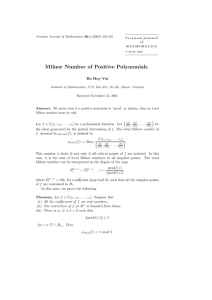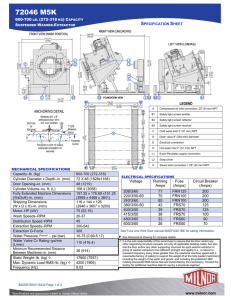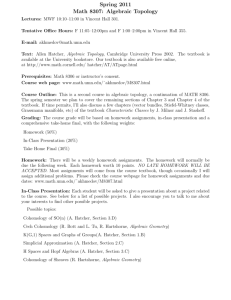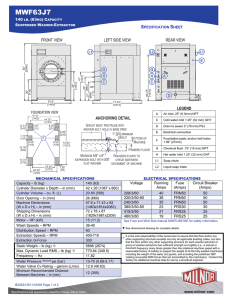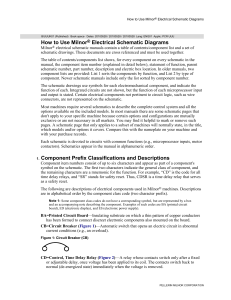Electrical Schematic - Pellerin Milnor Corporation
advertisement
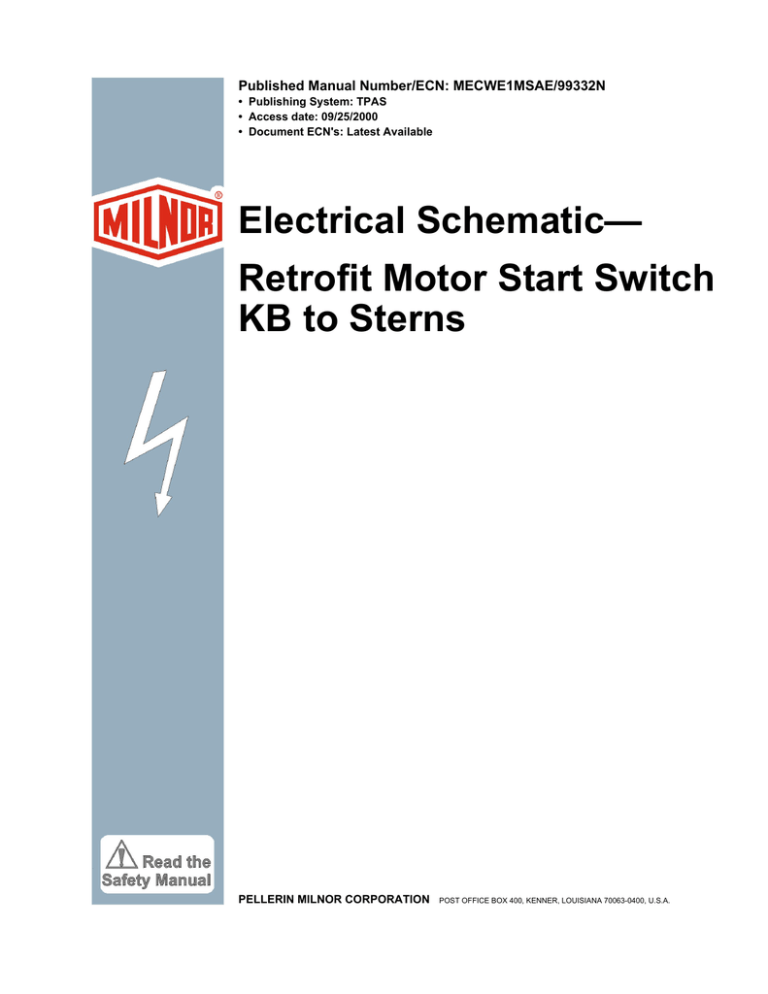
Published Manual Number/ECN: MECWE1MSAE/99332N
• Publishing System: TPAS
• Access date: 09/25/2000
• Document ECN's: Latest Available
Electrical Schematic—
Retrofit Motor Start Switch
KB to Sterns
PELLERIN MILNOR CORPORATION
POST OFFICE BOX 400, KENNER, LOUISIANA 70063-0400, U.S.A.
Please Read
About the Manual Identifying Information on the Cover
The front cover displays pertinent identifying information for this manual. Most important, are
the published manual number (part number) /ECN (date code). Generally, when a replacement
manual is furnished, it will have the same published manual number, but the latest available
ECN. This provides the user with the latest information applicable to his machine. Similarly all
documents comprising the manual will be the latest available as of the date the manual was
printed, even though older ECN dates for those documents may be listed in the table of
contents.
When communicating with the Milnor factory regarding this manual, please also provide the
other identifying information shown on the cover, including the publishing system, access date,
and whether the document ECN’s are the latest available or exact.
References to Yellow Troubleshooting Pages
This manual may contain references to “yellow pages.” Although the pages containing
troubleshooting procedures are no longer printed on yellow paper, troubleshooting instructions, if
any, will be contained in the easily located “Troubleshooting” chapter or section. See the table of
contents.
Trademarks of Pellerin Milnor Corporation
The following, some of which may be used in this manual, are trademarks of Pellerin Milnor
Corporation:
Ampsaver®
Autolint®
Auto-Purge®
Autovac
CBW®
Dye-Extractor®
Dyextractor®
E-P Plus®
Gear Guardian®
Hands-Off®
Hydro-Cushion®
Mildata®
Milnet®
Milnor®
Miltrac
Miltron
Comments and Suggestions
Help us to improve this manual by sending your comments to:
Pellerin Milnor Corporation
Attn: Technical Publications
P. O. Box 400
Kenner, LA 70063-0400
Fax: (504) 469-1849
Staph-Guard®
System 4®
System 7®
Totaltrol®
Table of Contents
for MECWE1MSAE/99332N
Retrofit Motor Start Switch KB to Sterns
Page
Description
1
3
4
10
20
Warranty
BMP720097/92732A
How to Order Parts
BMP720097R/72332A
Safety Instructions for Washer-Extractor Operation
MSOP0205AE/9322CV
How to Use Electrical Schematics
MSFD0106AE/95041V
Mtr Sw Conversion KB to Sterns, 1Ph, 220/240V,
30015C4A/M4A/M4G/J/P/CWE/N4S/E After
July 85
WCWE1MS1/92667D
Mtr Sw Conversion KB to Sterns, 1Ph, 110/120V,
30015C4A/M4A/G/J/P/CWE/N4S/E After July
85
WCWE1MS2/92667D
Mtr Sw Conversion,KB to Sterns, 1Ph, 208/220/240V,
30015C4M/P, After August 86
WCWE1MS3/92667D
Mtr Sw Conversion KB to Sterns, 1Ph, 220/240V,
30015CWE/N4S/N4E Before July 85
WCWE1MS4/92667D
Mtr Sw Conversion KB to Sterns, 1Ph, 110/120V,30015CWE/N4S/N4E,
Before July 85
WCWE1MS5/92667D
Mtr Sw Conversion KB to Sterns, 1Ph, 208/220/240V,
30015C4M/C4P Before August 86
WCWE1MS6/92667D
22
24
26
28
30
Document/ECN
3(//(5,10,/125&25325$7,21
/,0,7('67$1'$5':$55$17<
We warrant to the original purchaser that MILNOR machines including electronic
hardware/software (hereafter referred to as “equipment”), will be free from defects in material
and workmanship for a period of one year from the date of shipment from our factory with no
operating hour limitation. This warranty is contingent upon the equipment being installed,
operated and serviced as specified in the operating manual supplied with the equipment, and
operated under normal conditions by competent operators.
Providing we receive written notification of a warranted defect within 30 days of its discovery,
we will – at our option – repair or replace the defective part or parts, FOB our factory. We
retain the right to require inspection of the parts claimed defective in our factory prior to
repairing or replacing same. We will not be responsible, or in any way liable, for unauthorized
repairs or service to our equipment, and this warranty shall be void if the equipment is repaired
or altered in any way without MILNOR’s written consent.
Parts which require routine replacement due to normal wear – such as gaskets, contact points,
brake and clutch linings and similar parts – are not covered by this warranty, nor are parts
damaged by exposure to weather or to chemicals.
We reserve the right to make changes in the design and/or construction of our equipment
(including purchased components) without obligation to change any equipment previously
supplied.
ANY SALE OR FURNISHING OF ANY EQUIPMENT BY MILNOR IS MADE ONLY UPON
THE EXPRESS UNDERSTANDING THAT MILNOR MAKES NO EXPRESSED OR IMPLIED
WARRANTIES OF MERCHANTABILITY OR FITNESS FOR ANY PARTICULAR USE OR
PURPOSE. MILNOR WILL NOT BE RESPONSIBLE FOR ANY COSTS OR DAMAGES
ACTUALLY INCURRED OR REQUIRED AS A RESULT OF: THE FAILURE OF ANY OTHER
PERSON OR ENTITY TO PERFORM ITS RESPONSIBILITIES, FIRE OR OTHER HAZARD,
ACCIDENT, IMPROPER STORAGE, MISUSE, NEGLECT, POWER OR ENVIRONMENTAL
CONTROL MALFUNCTIONS, DAMAGE FROM LIQUIDS, OR ANY OTHER CAUSE BEYOND
THE NORMAL RANGE OF USE. REGARDLESS OF HOW CAUSED, IN NO EVENT SHALL
MILNOR BE LIABLE FOR SPECIAL, INDIRECT, PUNITIVE, LIQUIDATED, OR
CONSEQUENTIAL COSTS OR DAMAGES, OR ANY COSTS OR DAMAGES WHATSOEVER
WHICH EXCEED THE PRICE PAID TO MILNOR FOR THE EQUIPMENT IT SELLS OR
FURNISHES.
WE NEITHER ASSUME, NOR AUTHORIZE ANY EMPLOYEE OR OTHER PERSON TO
ASSUME FOR US, ANY OTHER RESPONSIBILITY AND/OR LIABILITY IN CONNECTION
WITH THE SALE OR FURNISHING OF OUR EQUIPMENT TO ANY BUYER.
BMP720097
92732A
1
2
How to order repair parts
Repair parts may be ordered either from the authorized dealer who sold you this
machine, or directly from the MILNOR factory. In most cases, your dealer will
have these parts in stock.
When ordering parts, please be sure to give us the following information:
1. Model and serial number of the machine for which the parts are required
2.
Part number
3. Name of the part
4. Quantity needed
5. Method of shipment desired
6. In correspondence regarding motors or electrical controls, please include all
nameplate data, including wiring diagram number and the make or
manufacturer of the motor or controls.
All parts will be shipped C.O.D. transportation charges collect only.
Please read this manual
It is strongly recommended that you read the installation and operating manual
before attempting to install or operate your machine. We suggest that this manual
be kept in your business office so that it will not become lost.
PELLERIN MILNOR CORPORATION
32%2;.(11(5/$86$
FAX: Administration 504/468-9307, Engineering 504/469-1849, Service 504/469-9777
BMP720097R
72332A
3
READ BEFORE USING MACHINE!
MSOP0205AE/9322CV (1 of 5)
ÈAFETY INSTRUCTIONS
S
FOR WASHER-EXTRACTOR OPERATION
General Safety Requirements
Ê
(specific warnings, next page and throughout manual)
Incorrect installation, neglected preventive maintenance, abuse, and/or improper repairs or changes to
the machine can cause unsafe operation and personal injuries, such as multiple fractures, amputations, or
death. The owner or his selected representative (owner/user) is responsible for understanding and ensuring
the proper operation and maintenance of the machine. The owner/user must familiarize himself with the
contents of all machine instruction manuals. The owner/user should direct any questions about these instructions to a Milnor® dealer or the Milnor® Service department.
Most regulatory authorities (including OSHA in the USA) hold the owner/user ultimately responsible
for maintaining a safe working environment. Therefore, the owner/user must do the following:
•
•
•
•
recognize all foreseeable safety hazards within his facility and take actions to protect his personnel,
equipment, and facility
require that personnel are familiar with all functional and safety aspects of the machine
ensure safety devices installed on the machine are in place and properly maintained
ensure all machine parts and assemblies are properly maintained.
Laundry Facility—Provide a supporting floor that is strong and rigid enough to support--with a reaË
sonable safety factor and without undue or objectionable deflection--the weight of the fully loaded machine
and the forces transmitted by it during operation. (For washer-extractors, see “ABOUT THE FORCES
TRANSMITTED BY MILNOR® WASHER-EXTRACTORS.”) Provide sufficient clearance for machine
movement. Provide any safety guards, fences, restraints, devices, and verbal and/or posted restrictions necessary to prevent personnel, machines, or other moving machinery from accessing the machine or its path.
Provide adequate ventilation to carry away heat and vapors. Ensure service connections to installed machines meet local and national safety standards, especially regarding the electrical disconnect (see the National Electric Code). Prominently post safety information, including signs showing the source of electrical
disconnect.
Personnel—Inform personnel about hazard avoidance and the importance of care and common sense.
Ë
Provide personnel with the safety and operating instructions that apply to them. Verify that personnel use
proper safety and operating procedures. Verify that that personnel understand and abide by point-of-hazard
tags on the machine and procedure-specific precautions in the instruction manuals.
Safety Devices—Ensure that no one eliminates or disables any safety device on the machine or in ths
Ë
facility. Do not allow machine to be used with any missing guard or cover. Service any failing or malfunctioning device before operating the machine.
Maintenance—Ensure the machine is inspected and serviced in accordance with the norms of good
Ë
practice and with the preventive maintenance schedule. Replace belts, pulleys, brake shoes/disks, clutch
plates/tires, rollers, seals, alignment guides, etc. before they are severely worn. Immediately investigate any
4
SAFETY INSTRUCTIONS
FOR WASHER-EXTRACTOR OPERATION
MSOP0205AE/9322CV (2 of 5)
The Danger From a Rotating Cylinder
Ê
A tremendous amount of potential energy is stored in the rotating cylinder of any washer-extractor
(even at slow speed). Washer-extractors are equipped with a door interlock designed to prevent the door
from being opened if the cylinder is turning and to prevent the machine from starting unless the door is
closed and locked.
Some smaller machines permit the door to be opened only during the first few minutes of the formula
and only while the machine is rotating in wash speed. If the door is opened, the drain valve opens immediately, the formula terminates, and (provided the machine still has electric power) on most, a brake is immediately applied.
All larger washer-extractors are equipped with a spring-applied, air-released brake which remains applied as long as the door is open and stops the cylinder whenever any of the following occurs: 1) the extract
cycle ends, 2) the extract is manually terminated, or 3) the machine loses electric power.
Most machines permit the cylinder to be inched or jogged at slow speed, but only with two hands.
ENTANGLE HAZARD—The linen inside or hanging partially outside the
turning cylinder can suddenly wrap around your hand, arm, or body and
twist off/sever it.
☞
☞
☞
☞
☞
☞
☞
☞
DO NOT put any part of your body in the machine while it is moving.
DO NOT operate the machine with the door open.
DO NOT open the door while the cylinder is turning.
DO NOT touch the linen or load/unload machine while the cylinder is turning.
DO NOT open the door if there is water in the machine. You can be scalded by hot water.
DO NOT tamper with or disable any safety device on the machine.
DO NOT operate the machine with a malfunctioning door interlock mechanism.
DO NOT operate the machine with malfunctioning two hand inching, if so equipped.
EXPLOSION HAZARD—A damaged cylinder can rip apart during extract,
throwing out metal fragments at high speed like an exploding grenade,
killing/injuring personnel and damaging property.
☞ DO NOT operate machine with any evidence of cylinder damage.
B
The Danger From Processing With Flammable Materials
Ê
Washer-extractors are manufactured specifically for use with water, not with any type solvent nor with
any other material that might be flammable. They are not suitable for any type of solvent cleaning process.
EXPLOSION AND FIRE HAZARDS—Goods containing flammable materials or fumes can explode or ignite spontaneously, killing/injuring personnel and damaging property.
☞ NEVER process goods containing any significant quantity of flammable chemical.
5
C
SAFETY INSTRUCTIONS
FOR WASHER-EXTRACTOR OPERATION
MSOP0205AE/9322CV (3 of 5)
The Danger From Operating With Guards or Covers Removed
Ê
Like other types of industrial equipment, Milnor® washer-extractors utilize high voltage electrical
power and, depending on model, pneumatic and hydraulic power to drive a wide variety of moving parts.
Even with external power completely removed, the machine may contain energy such as tensioned springs,
compressed air, and heavy parts that may fall if released. As previously stated, the washer cylinder acquires
tremendous potential energy during extract, which must be absorbed by the brake or permitted sufficient
time to dissipate. Every guard, side panel, and door on the machine exists to isolate energized or moving parts from laundry personnel and must be securely in place for safe operation.
ELECTROCUTION HAZARD—Electric boxes and other electrical components contain high voltage that will kill or seriously injure you on contact.
Power switch(es) on the machine disable only control circuit power, not
three-phase power.
☞ NEVER operate the machine with electric box doors open or any electrical conductors exposed.
☞ NEVER attempt any electrical repair or troubleshooting unless you are a qualified
electrician, authorized to work on the machine. Before proceeding, service personnel must consult all applicable safety and service information displayed on
the machine and provided in the manuals.
CRUSH AND ENTANGLE HAZARDS—Moving components such as belts,
hydraulics, tilting machine housings, etc., can entangle, crush and/or
sever parts of your body, killing or severely injuring you.
☞ NEVER operate machine with any guards, covers, or side panels removed.
☞ NEVER permit anyone to place any part of his body inside any part of the machine
housing when the machine is operational.
☞ NEVER attempt any mechanical repair or troubleshooting unless you are a qualified mechanic, authorized to work on the machine. Before proceeding, service
personnel must consult all applicable safety and service information displayed
on the machine and provided in the manuals.
☞ ALWAYS make sure personnel are clear of machine before starting it.
6
SAFETY INSTRUCTIONS
FOR WASHER-EXTRACTOR OPERATION
MSOP0205AE/9322CV (4 of 5)
The Danger From a Malfunctioning Clutch System
Ê
The low speed (wash speed) drive train on machines with multiple motor drives is disengaged during
extract. At the end of extract, the cylinder will slow down before the low speed drive train is permitted to
re-engage. Although extremely unlikely in a properly maintained machine, a malfunction could cause
the low speed drive to engage prematurely (a possibility in all types of industrial machines that utilize
clutches to switch between high speed and low speed operating cycles).
EXPLOSION HAZARD for machines with multiple motor drives—Pulleys
can be spun fast enough to explode into shrapnel-like fragments, injuring
personnel and/or damaging property, if the low speed drive engages during or at the end of extract.
☞ IMMEDIATELY shut down the machine if any of these conditions occur:
• The machine makes a sound like skidding automobile tires as it comes out of
extract,
• The wash or drain clutch does not disengage or it reengages during extract,
• V-belts jump off at the start of, during, or at the end of extract,
• A strange whining sound occurs at any time during extract.
☞ DO NOT permit the machine to operate until the cause of the offending condition
is found and remedied.
7
SAFETY INSTRUCTIONS
FOR WASHER-EXTRACTOR OPERATION
MSOP0205AE/9322CV (5 of 5)
Special Safety Considerations for Tilting Machines
Ê
Restricted areas must be established and maintained around tilting machines to protect laundry
personnel from being struck or crushed when the machine tilts.
Tilt washer-extractors that pivot at both the front and rear of the machine have redundant safety limit
switches and electrical interlocks designed to prevent the machine from 1) tilting forward (rear up) unless
both front-down limit switches are depressed, and 2) tilting rearward (front up) unless both rear-down limit
switches are depressed. Because the safety limit switches and electrical interlocks cannot be bypassed at the
operator control panel, these ensure safe tilting during normal operation if the safety limit switches and all
related components and circuitry are in proper working order. Electrical interlocks and safety limit
switches are ignored when the machine is tilted manually with the hydraulic tilting valves. This procedure must be restricted to competent, knowledgeable, authorized service personnel.
CRUSH HAZARD—Machine will crush body parts caught in mechanisms
during tilting. Personnel behind, above, or in front of machine may be
crushed if caught between machine and a nearby object during tilting.
☞ NEVER tilt machine with any guards, covers, or side panels removed.
☞ NEVER permit anyone to place any part of his body inside or under machine when
the machine is operational.
☞ NEVER permit anyone on top of the machine or within restricted areas around the
machine when the machine is operational. Laundry must restrict access to dangerous areas.
☞ ALWAYS ensure personnel are clear of machine before tilting.
☞ NEVER operate a tilting machine unless all tilting components, including but not limited to safety limit switches, electrical interlocks, and operator controls, are functioning properly.
☞ NEVER attempt to test or perform maintenance on any portion of the tilting
mechanisms unless you are a qualified mechanic authorized to work on the machine. Before proceeding, service personnel must consult all applicable safety
and service information displayed on the machine and provided in the manuals.
☞ NEVER attempt to tilt the machine using the hydraulic tilting valves unless you
are a qualified mechanic authorized to work on the machine. Before using manual
hydraulic controls, service personnel must thoroughly understand the system
and all consequences of manual operation.
CRUSH HAZARD for machines with both front and rear pivots—A tilted
machine may lunge forward or rearward and even fall over, crushing personnel, if the tilt wheels at the non-tilted end are raised out of their cradles.
☞ NEVER tilt machine using the hydraulic tilting valves unless you are a qualified mechanic authorized to work on the machine. These valves bypass all safeties.
8
C
9
MSFD0106AE/95041V (1 of 5)
R
HOW TO USE MILNOR ELECTRICAL SCHEMATICS
…
Milnor electrical schematic manuals contain a table of contents/component list, a set of schematic drawings, and a signal routing table. These documents are cross referenced and must be used together.
R
The table of contents/components list shows, for every component on every schematic in the manual, the
component item number(explained in detail below), statement of function, parent schematic number, part number,
description and electric box location.
The schematic drawings use symbols for each electro-mechanical component, and indicate the function of
each. Integrated circuits are not shown, but the function of each microprocessor input and output is stated. Certain
electrical components not pertinent to circuit logic, such as wire connectors, are not represented on the schematic
but are shown in the signal routing table. Most machines (manuals) require several schematics to describe the
complete control system including all available options. However, this means that there are usually some
schematics that do not apply to a specific machine. Each schematic is devoted to circuits with common functions
(e.g., microprocessor inputs, motor contactors). Schematics appear in the manual in alphanumeric order.
The signal routing table assists in determining wire routing. It identifies each group of conductors in a control
system connected with zero resistance. Groups are identified by a two or three character wire number. Each wire
belonging to such a group of conductors has that group’s wire number printed along the wire insulation. Although
there are some exceptions, generally each group of conductors within the entire electrical system for a machine
family has its own unique wire number. The signal routing table for the manual lists each wire alphanumerically by
wire number and each component/pin number to which the wire is attached, including those not shown on the
schematics (e.g., wire connectors). Milnor document MSTS0202BE HOW TO USE THE SIGNAL ROUTING
TABLE provides more information.
R
Component Prefix Classifications and Descriptions
The component item numbers consist of up to six characters and appear as part of a component’s symbol on
the schematic. The first two characters indicate the general class of component and the remaining characters are a
mnemonic for the function. For example, CD is the code for all time delay relays and SR stands for safety reset.
Thus, CDSR is a time delay relay that serves as a safety reset.
The following are descriptions of the electrical components used in Milnor
alphabetical order of the component class code (two character prefix).
R
machines. Descriptions are in
BA=Printed Circuit Board Insulating substrate on which a thin pattern of copper conductors has been
À
formed to connect discreet electronic components also mounted on the board.
CB=Circuit Breaker Automatic switch that opens an electric circuit in abnormal curÀ
rent conditions (e.g., an overload).
10
CD=Control, Time Delay Relay A relay whose contacts
À
switch only after a fixed or adjustable delay, once voltage has been applied to its coil. The contacts switch back to normal (de-energized state)
immediately when the voltage is removed.
À
CL=Control, Latch Relay A re la y w h ic h
latches in an energized or set position when operated
by one coil (the latch/set coil). The relay stays latched,
even though coil voltage is removed. The relay
releases or unlatches when voltage is applied to a
second coil, (the unlatch/reset coil).
CR=Control, Relay A relay whose contacts switch immediately
À
when voltage is applied to its coil and revert to normal when the voltage
is removed.
À
CP=Control, Photo-Eyes Photo-eyes sense the presence of
an object without direct physical contact. Photo-eyes consist of a transmitter, receiver, and output module.These components may be housed
in one assembly with the transmitter bouncing light off of a reflector to
the receiver, or these components can be housed in two separate assemblies with the transmitter pointed directly at the receiver.
The photo-eye can be set to turn on its output either when the light
beam becomes blocked (dark operate) or when it becomes unblocked
(light operate).
11
R
HOW TO USE MILNOR ELECTRICAL SCHEMATICS
R
CS=Control, Contactor/Motor Starter A relay capable of handling heavier electrical loads, usually a
À
motor.
EB=Electric Buzzer An audible signaling device.
À
EC=Electric Clutch A clutch consists of a coil and a rotor. The rotor has two separate rotating plates. These
À
plates are free to rotate independent of each other until the coil is energized. Once energized the two plates turn as
one.
ED=Electronic Display A visual presentation of data, such as an LCD (liquid crystal display), LED (light
À
emitting diode) display, or VFD (vacuum florescent display).
EF=Electric Fuse A fuse is an over-current safety device with a circuit opening fusible member which is
À
heated and severed by the passage of over-current through it.
EL=Electric Light Indicator lights may be either incandescent or fluorescent.
À
EM=Electro Magnet Solenoid A device consisting of a core surrounded by a wire coil through which an
À
electric current is passed. While current is flowing, iron is attracted to the core (e.g., a pinch tube drain valve solenoid).
ES=Electronic Power Supply A device that converts AC (alternating current) to filtered and regulated DC
À
(direct current). The input voltage to the power supply is usually 120 or 240 VAC . The output is +5, +12, and -12 VDC.
ET=Thermal Overload A safety device designed to protect a motor. A thermal
À
overload consists of an overload block, heaters, and an auxiliary contact. The auxiliary
contact is normally installed in a safety (three-wire) circuit that stops power to the motor
contactor coil when a motor overload occurs.
EX=Electrical Transformer A device that transfers electrical energy from
À
one isolated circuit to another, often raising or lowering the voltage in the process.
12
MSFD0106AE/95041V (2 of 5)
KB=Keyboard Device similar to a typewriter for making entries to a computer.
À
MN=Electronic Monitor (CRT) A cathode ray tube used for visual presentation of data.
À
MR=Motors Electro-mechanical device that converts electrical energy into mechanical energy.
À
MV=Motor (Variable Speed) Inverter To vary the speed of an AC motor, the volts to frequency ratio
À
must be kept constant. The motor will overheat if this ratio is not maintained.
The motor variable speed inverter converts three phase AC to DC. The inverter then uses this DC voltage to
generate AC at the proper voltage and frequency for the commanded speed.
NOTE: Switch symbols used in the schematics and described below always depict the switch in its
unactuated state.
PX=Proximity Switch A device which reacts to the proximity of an target
À
without physical contact or connection. The actuator or target causes a change in the
inductance of the proximity switch which causes the switch to operate. Proximity
switches can be two-wire (AC) or three-wire (DC) devices.
SC=Switch, Cam Operated A switch in which the electrical contacts are opened and/or
À
closed by the mechanical action of a cam(s). Applications include 35-50 pound timer operated
machines, autospot, timer reversing motor assembly, and some balancing systems.
SH=Switch, Hand Operated A switch that is manually operated (e.g., Start button,
À
Master switch, etc.).
SK=Switch, Key Lock A switch that requires a key to operate . This prevents unauthorized
À
personnel from gaining access to certain functions (e.g., the Program Menu).
SL=Switch, Level Operated A switch connected to a float that causes the switch to open
À
and close as the level changes.
13
HOW TO USE MILNOR R ELECTRICAL SCHEMATICS
SM=Switch, Mechanically Operated A switch that is mechanically operated by a part of
À
or the motion of the machine (e.g., door closed switch, tilt limit switches, etc.)
SP=Switch, Pressure Operated A switch consisting of a diaphragm that
À
pushes against a switch actuator.
ST=Switch, Temperature Operated A switch that is actuated at a preset temperature
À
(e.g., dryer safety probes) or has adjustable set points (e.g., Motometers or Combistats).
TB=Terminal Board A strip or block for attaching or terminating wires.
À
VE=Valve, Electric Operated A valve operated by an electric coil to control the flow of
À
fluid. The fluid can be air, water or hydraulics.
ZF=Rectifier A solid state device that converts alternating current to
À
direct current.
À
WC=Wiring Connector A coupling device for joining two cables or connecting a cable to an electronic
circuit or piece of equipment. Connectors are male or female, according to whether they plug into or receive the
mating connector.
14
MSFD0106AE/95041V (3 of 5)
Component Terminal Numbering
NOTE: Numbers shown usually appear on the component.
15
HOW TO USE MILNOR R ELECTRICAL SCHEMATICS
R
Features of Milnor Electrical Schematics
Document W6DRYGS+A shown on the next page, is part of an actual schematic for the Milnor Gas Dryer.
For the purposes of this instruction, the schematic is shown gray and explanations of the items on the schematic are
shown black.
The item numbers below correspond to the circled item numbers shown on the drawing.
¬ The first six characters of the drawing number (W6DRYG)indicate that this is a wiring diagram (W), identify the generation of controls (6), and identify the type of machine (DRYG=Gas Dryer). These characters
appear in the drawing number of every schematic in the set.
The characters following the first six are unique to each drawing. The two characters identified as the page
number are an abbreviation for the function performed by the depicted circuitry (S+=three-wire circuit) and
establish the order in which the schematic occurs in the manual (schematics are arranged in alpha-numeric
order in the manual).
Whenever circuitry changes are significant enough to warrant publishing a new schematic drawing, the new
drawing number will be the same as the old except for the major revision letter ( A in the example).
­ Included in the drawing title are the class of control system, the title of this circuit, and the circuit voltage.
® Line numbers are provided along the bottom edge of the drawing. These permit service personnel in the field
and at the Milnor factory to quickly relate circuit locations when discussing troubleshooting over the
phone. Page and line numbers are referenced on the drawing as explained in items five and six below.
¯ General functions of the circuit or portions thereof are stated across the top edge of the drawing.
° Relay contacts show the page and line number on which the relay coil may be found. This is the type of
cross referencing most frequently used in troubleshooting.
± Relay coils show the page and line number on which its associated contacts are located.
² Relay contacts and relay coils show the physical location of the relay.
16
MSFD0106AE/95041V (4 of 5)
³ The designation MTA applies to electronic circuit board connections. Typically, a control system will con-
tain several different types of circuit boards and one or more boards of each type. A numerical suffix identifies the board type and a numerical prefix identifies which one of several boards of a given type is being
depicted. For example, the designation 1MTA5 identifies this as the first I/O board (8 output, 16 input
board) in the control system. As shown on the drawing, a pin number follows the board number, separated
by a dash. Thus, 1MTA5-9 is pin 9 on this board. The numerical designations for board types vary from one
control system to another. Some of the board types commonly encountered on the Mark II washer-extractor
control and their designations are as follows:
MTA1-MTA6 = 8 output, 16 input (8/16) boards.
MTA11-MTA16 = 16 output boards
MTA30-MTA40 = processor boards
MTA41-MTA43 = digital to analog (D/A) boards
MTA51-MTA56 = analog to digital (A/D) boards
The complete listing of the boards utilized in a given control system can be found in the component list for
that system.
´ The wire numbers, as described in the explanation of the signal routing table at the beginning of this section,
are shown at appropriate locations on the schematic drawing.
µ Where diamond symbols appear at the end of a conductor, these are match points for continuing the
schematic on another drawing. The page and line number that continues the circuit is printed adjacent to the
diamond symbol. Where more than one match point appears on the referenced page, match diamonds containing corresponding letters.
17
4
5
6
7
10
18
8
1
9
2
3
19
WCWE1MS1
92667D
20
21
WCWE1MS2
92667D
22
23
WCWE1MS3
92667D
24
25
WCWE1MS4
92667D
26
27
WCWE1MS5
92667D
28
29
WCWE1MS6
92667D
30
31
